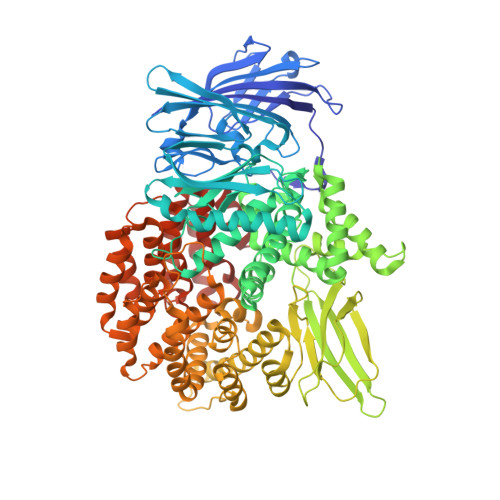Potent dual inhibitors of Plasmodium falciparum M1 and M17 aminopeptidases through optimization of S1 pocket interactions.
Drinkwater, N., Vinh, N.B., Mistry, S.N., Bamert, R.S., Ruggeri, C., Holleran, J.P., Loganathan, S., Paiardini, A., Charman, S.A., Powell, A.K., Avery, V.M., McGowan, S., Scammells, P.J.(2016) Eur J Med Chem 110: 43-64
- PubMed: 26807544
- DOI: https://doi.org/10.1016/j.ejmech.2016.01.015
- Primary Citation of Related Structures:
4ZW3, 4ZW5, 4ZW6, 4ZW7, 4ZW8, 4ZX3, 4ZX4, 4ZX5, 4ZX6, 4ZX8, 4ZX9, 4ZY0, 4ZY1, 4ZY2, 4ZYQ - PubMed Abstract:
Malaria remains a global health problem, and though international efforts for treatment and eradication have made some headway, the emergence of drug-resistant parasites threatens this progress. Antimalarial therapeutics acting via novel mechanisms are urgently required. Plasmodium falciparum M1 and M17 are neutral aminopeptidases which are essential for parasite growth and development. Previous work in our group has identified inhibitors capable of dual inhibition of PfA-M1 and PfA-M17, and revealed further regions within the protease S1 pockets that could be exploited in the development of ligands with improved inhibitory activity. Herein, we report the structure-based design and synthesis of novel hydroxamic acid analogues that are capable of potent inhibition of both PfA-M1 and PfA-M17. Furthermore, the developed compounds potently inhibit Pf growth in culture, including the multi-drug resistant strain Dd2. The ongoing development of dual PfA-M1/PfA-M17 inhibitors continues to be an attractive strategy for the design of novel antimalarial therapeutics.
Organizational Affiliation:
Biomedicine Discovery Institute and Department of Microbiology, Melbourne, VIC 3800, Australia; Department of Biochemistry and Molecular Biology Monash University (Clayton Campus), Melbourne, VIC 3800, Australia.




















